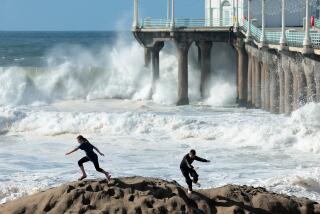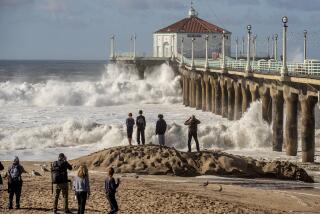Surfing secret catches a wave of notoriety
HALF MOON BAY -- It was a day made for the madmen of surfing--20-foot walls of water rising into the clear skies and then collapsing with the power and speed of a locomotive.
By the time Mark Foo had slipped into his wet suit and started stroking into the cold water, a crowd had gathered beneath the rocky bluffs that tower over Maverick’s Beach. In this most unlikely of spots--just 25 miles south of San Francisco--they had come to see one of the masters of monster waves, an athlete who believed that surf should be conquered, not finessed.
Hearing that Maverick’s was breaking big, Foo had hopped an overnight flight from his home in Oahu, a video crew from his nationally syndicated cable show in tow to document his latest conquest. But on this day, Dec. 23, Foo would be defeated.
As he descended a towering wave, he lost his balance, was pitched into the thick curl and was buried under an avalanche of churning white water. Foo’s body and broken surfboard were found two hours later by some boaters near the entrance of a nearby harbor. Medical examiners said the muscularly handsome 36-year-old athlete had drowned.
“We always knew someone would die at Maverick’s,” said Darin Bingham, co-owner of the Aqua Culture surf shop a couple of miles down the coast. “We just never thought it would be someone like Mark Foo. It will just add to the lore and legend of this spot.”
Until recently, that spot had been a secret so closely guarded by a handful of locals that not even the venerable Surfer magazine knew of its existence until the early ‘90s, when it spread the word. But Foo’s death has changed all that, casting the glare of publicity on the home of some of the biggest waves in the world, rivaling anything the North Shore of Oahu or the Mexican island of Todos Santos has to serve up.
Now, like an unbeaten gunslinger, Maverick’s will draw more and more challengers, said Bob McMahon, harbor master at Pillar Point Harbor at the south end of Maverick’s. “People will consider it a challenge to do the wave that did Foo in.”
Maverick’s, named after a local surfer’s dog, remained largely unknown for so long because of its difficult access and because even the most adventurous surfers--and they are adventurous--did not explore the area because most of the waves around Half Moon Bay are relatively small.
The beach itself is more than a mile from the nearest road, an isolated stretch of sand and tide pools under sheer cliffs as high as 100 feet. The waves are hidden from motorists on nearby Pacific Coast Highway.
Those who make it there after a milelong walk around the cliffs and along the beach are greeted with an aging Army Corps of Engineers sign: “Dangerous wave conditions exist even on calm days.”
The surf soars at Maverick’s because of its geography and geology. When arctic storms send swells churning southward, gaining momentum for more than 1,000 miles, the first thing they hit is a reef off tiny Pillar Point, a peninsula that juts out into the Pacific at Half Moon Bay. There, the sea bottom abruptly rises from a depth of more than 100 feet to only a few feet, punching the swells skyward.
When everything falls into place, which is only about 15 to 30 times a year, Maverick’s produces “the most radical wave on the planet,” said surfer Jeff Clark, who was in the water with Foo the day he died. “It is what surfing is all about.”
He should know. Clark kept the secret of Maverick’s for 15 years--until he got tired of surfing perfect waves by himself.
He discovered them as a boy. “They were breaking there every winter, just by themselves,” he said. “It was the biggest thing I’d ever seen, and it had never been ridden.”
Clark kept watching--and keeping it to himself--until 1975, when as an 18-year-old, he ventured out on his board. He continued to do so for more than a decade. “I was the lone ranger out there,” he said.
Eventually, some of Clark’s surfing buddies would paddle out with him--not to ride the huge waves, but just to keep him company. “It was nice to have someone else see what a wild, ominous place it is,” he said.
Finally, in the winter of 1989, while he was working a construction job in San Francisco, Clark invited two of his surfing co-workers to join him. “I said, ‘You guys want to see the biggest, most powerful waves?’ ”
Of course they did. And so the word was out, soon reaching Surfer magazine, whose editors were floored--and a little embarrassed--that they had no clue of Maverick’s existence right here in California.
“How do you think we felt when we found out?” Steve Hawk, the magazine’s editor, said sheepishly. Hawk said the magazine broke the story in January, 1992--running a photograph on the cover of a huge Maverick’s wave, headlined: “Cold Sweat.”
“It shocked the surfing world,” Hawk said.
The discovery of such a place, especially in the shadow of a large city, was unimaginable, Hawk said, adding that if there are other breaks waiting to be discovered, then they are certain to be in remote places such as Peru or South Africa. Maybe.
Since Surfer blew the cover on Maverick’s, it has become a can’t-miss stop on the international big-wave circuit. When it’s breaking, some of the best surfers in the world are there, paddling into waves with crest-to-trough drops as fast as a runaway elevator.
For the most part, such waves are the domain of only a few hundred surfers of the thousands upon thousands in the world who crowd coastal stretches. Big-wave surfing takes its own set of skills and its own tolerance for danger. As Aron Chin, 22, a surfer from Rockaway Beach just up the coast, put it: “It’s not a sport, it’s a rush. More like sky-diving.”
Remarkably, despite the risks, only a few surfers have died in big waves during the past 50 years. Even Foo’s friends say it was just a sad quirk of fate that he lost his life on a wave smaller than many he had handled before.
In fact, experts say, more deaths have occurred among surfers riding smaller waves because of such factors as crowded conditions, shallow bottoms and less-experienced riders.
Still, some Maverick’s surfers and local harbor officials worry that the publicity surrounding Foo’s death will now bring even more people here, increasing the chances for another tragedy.
“It’s so mystical. It’s so dangerous,” said Santa Cruz surfer Shawn Santos, 24, who was standing at the water’s edge this week. “And it’s going to be so crazy the next couple of years because of this.”
On the day Foo died there were close to 100 cars in the dirt parking lot near Maverick’s and winding down the back streets. The next day, there were 500, according to harbor master McMahon.
“We had to close the road Saturday. It was gridlock,” said McMahon, who has worked at the harbor for 21 years.
Many of those who made the journey to Maverick’s in the wake of Foo’s death were not surfers but tourists and Bay Area residents who had seen news footage of the giant waves and wanted a closer look.
“I saw it on the news and thought, ‘My God, it’s right in my back yard,’ ” said Chris Tortorelli, 24, of San Jose, about an hour’s drive away.
But unlike many in Half Moon Bay, Clark believes that the tragedy at Maverick’s will have a sobering effect on the surfing community. “I think it will slow way down,” he said. “People don’t want to die.”
He may be right.
Two days after Foo’s death, Clark decided that it was time to get back into the water.
At 7 a.m. he drove down the familiar back roads. “It was desolated, like before. I paddled out and surfed for two hours. Nobody there. I came out, walked down the path and still nobody,” he said.
The experience eerily echoed Clark’s statement to Surfer magazine:
“Guys will come out there, take a bad wipeout and before you know it, it’ll be me and my friends again.”
More to Read
Sign up for our L.A. Times Plants newsletter
At the start of each month, get a roundup of upcoming plant-related activities and events in Southern California, along with links to tips and articles you may have missed.
You may occasionally receive promotional content from the Los Angeles Times.






